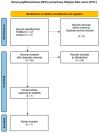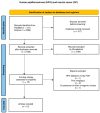Human Papillomaviruses and Malignant Neoplasms of the Female Upper Reproductive Tract: A Comprehensive Review of the Literature
- PMID: 40563645
- PMCID: PMC12190943
- DOI: 10.3390/cancers17121995
Human Papillomaviruses and Malignant Neoplasms of the Female Upper Reproductive Tract: A Comprehensive Review of the Literature
Abstract
Malignancies of the female upper reproductive tract, especially endometrial and ovarian cancers, generate a significant burden for women worldwide. The possible etiopathogenetic role of chronic human papillomavirus (HPV) infection in the carcinogenesis of the female upper genital tract is neither clearly established not completely understood. Therefore, we performed a literature review, using the PubMed and SCOPUS electronic databases, of the prevalence of HPV DNA in endometrial, primary fallopian tube, ovarian, and primary peritoneal cancers, as well as uterine sarcomas. The present investigation covered 35 studies from different countries on various continents. Overall, the prevalence of HPV was approximately 15% in all the above cancers. HPV DNA was isolated from 11%, 0%, 0%, and 14% of endometrial carcinomas, uterine sarcomas, primary fallopian tube cancers, and ovarian malignant neoplasms, respectively. No relevant studies on primary peritoneal cancers were retrieved. The predominant HPV strain from tumors of the upper female reproductive tract, regardless of the tumor site, was HPV-16, followed by HPV-18. The HPV DNA identified was exclusively from subtypes HPV-6, HPV-11, HPV-16, HPV-18, and HPV-33, which are responsible for the development of not only cervical cancer, but also condylomata acuminata. The findings of the present review indicate that HPV vaccination might prove to be a useful strategy in the prevention of HPV-related carcinomas of the upper genital tract in women.
Keywords: endometrial cancer; fallopian tube cancer; human papillomavirus; ovarian cancer; primary peritoneal cancer; uterine corpus cancer; uterine sarcoma.
Conflict of interest statement
The authors declare no conflicts of interest.
Figures





References
Publication types
LinkOut - more resources
Full Text Sources

